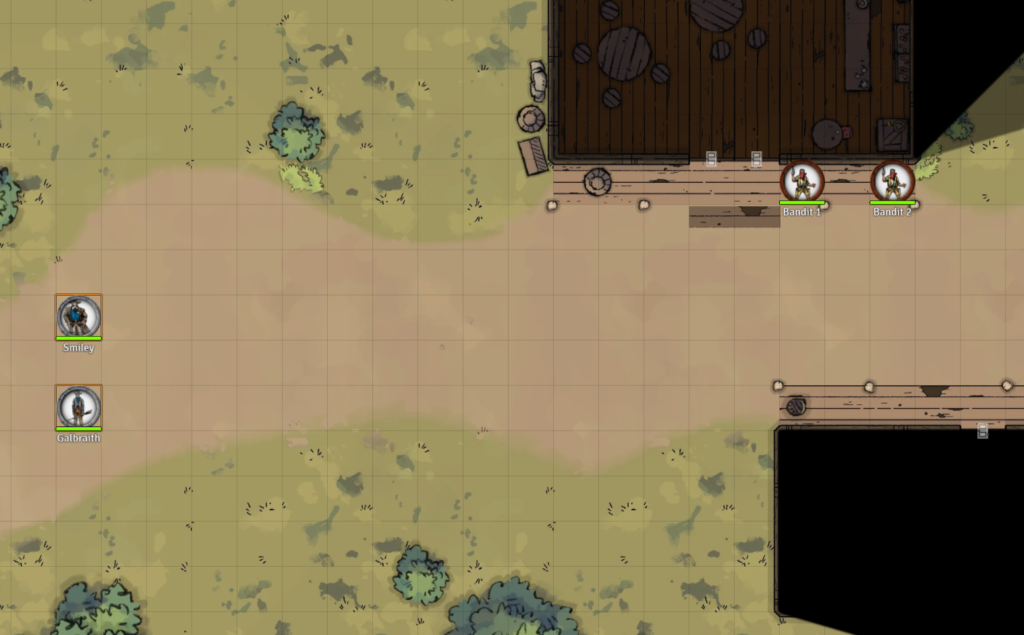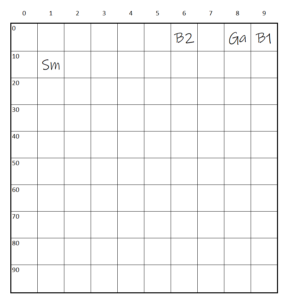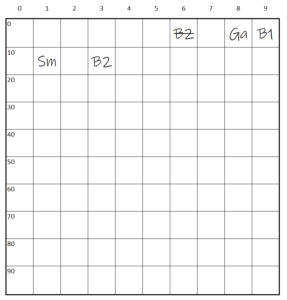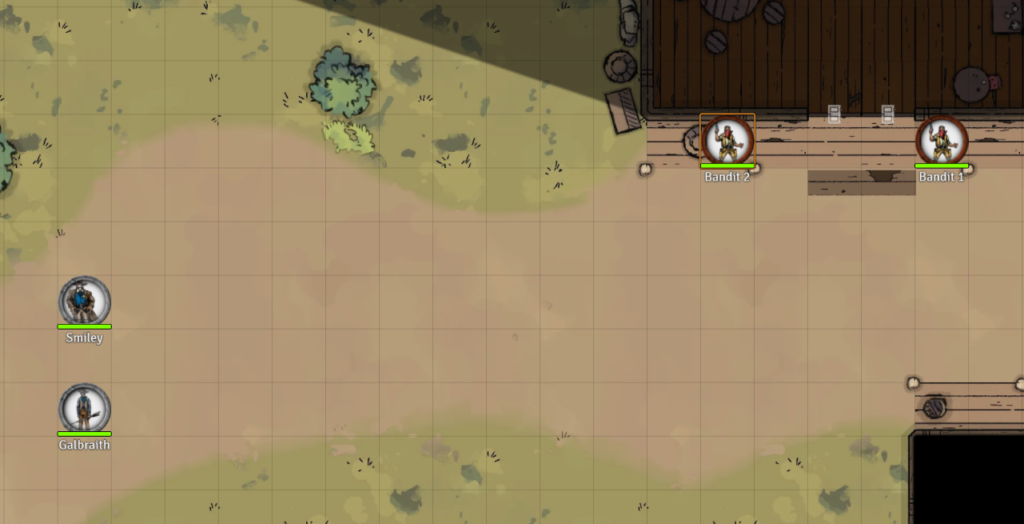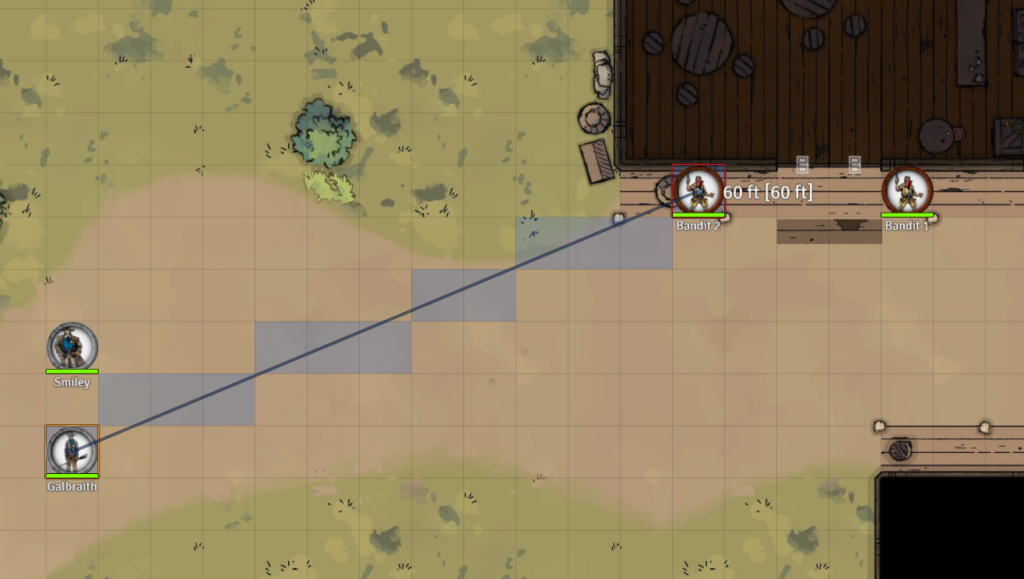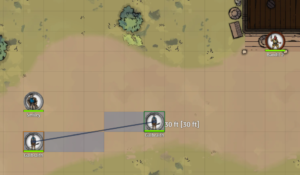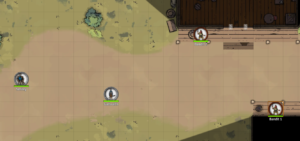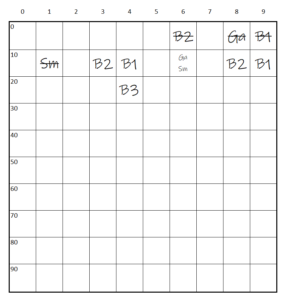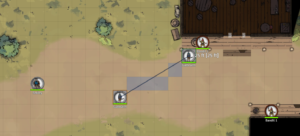Sample Combat
The following example will attempt to walk you through a sample combat between multiple combatants. Because of the differences between 99 Towers and other popular roleplaying games, this example will be (overly) verbose.
Aldor “Smiley” Tuggs and Galbraith Maurice Hatry, two men just starting the adventuring lifestyle, are walking up a street in the town of Red Veil. Unfortunately, there’s a local gang, the Blood Hawks, that doesn’t appreciate strangers. Walking up a street in broad daylight is basically just asking for a fight to break out. Two bandits lounging on the porch of the Old Crow Saloon rise to their feet and draw weapons.
Note: All maps are made with DungeonDraft and imported into FoundryVTT for these examples. Some of the map assets are from 2-Minute Tabletop and others are from Forgotten Adventures.
There’s no posturing or attempts to parlay. Smiley and Galbraith might be inexperienced, but they’re not stupid. They know a fight when they see it. All participants flip for Initiative to determine when they’re going to act. The GM rules that no one is surprised and everyone has weapons out and ready. The bandits are both armed with a pistol and an off-hand knife.
It doesn’t come into play in this combat, but it’s helpful to remember the flat-footed rule:
Flat-Footed
Until a character acts in combat, he is flat-footed. Flat-Footed characters lose the Soft Strength [SS] bonus they get to Physical Defense <PD>. You also cannot make Opportunity Attacks while Flat-Footed.
Initiative
The two bandits have the same profile. Both have Initiative <N> 2. Smiley also has a <N> of 2, while Galbraith has a <N> of 3. The GM will flip two cards for each bandit (although if there were more bandits, he could group some together with the same Initiative flip) and add 2 to the value. Smiley flips two cards and adds in his <N> of 2. Galbraith gets to flip three cards, keeping the best, and adding 3. Then those scores are subtracted from 20 to determine the first phase each participant will act on.
- Bandit 1: 9 of Clubs. Initiative 9 + 2 = 11. First phase = 9.
- Bandit 2: Queen of Spades. Initiative 12 + 2 = 14. First phase 6.
- Smiley: 7 of Clubs. Initiative 7 + 2 = 9. First phase = 11.
- Galbraith: 9 of Clubs: Initiative 9 + 3 = 12. First phase 8.
(Only the highest of the cards flipped is shown above)
Phase Zero
No one in this example combat has mana or the ability to use spells. If a character did, however, he would recover one mana in phase zero (and 10, 20, etc.). It’s unlikely that anyone would need to do this in phase zero, but it could happen. There may be other game effects that can trigger on the “zeroes” as well.
Phase 6 (Bandit 2)
Phase 6 is the first time anyone will act in this encounter. Bandit 2 wants to run down the saloon porch and take cover behind that barrel. However, that space is 6 squares away and the bandits only have a <SPD> of 5. Bandit 2 chooses to take a Reckless Move:
Reckless Move (7 phases)
Unlike a Combat Move, where you are assumed to be on your guard, a Reckless move sacrifices defenses for speed. When using a Reckless Move action, you can move double your Speed (doubling your base plus and any movement power components) but take severe penalties to defense. You take a (flip-1) for all opposed combat checks until the start of your next activation.
With his speed doubled to 10, the bandit can easily make it to a spot behind the barrel. As Reckless Move takes 7 phases, Bandit 2 will next act in phase 13. This is shown on the Combat Clock like this:
Note: The phrase “all opposed combat checks” would include the bandit making defense flips and also opportunity attack flips made before his next activation.
Phase 8 (Galbraith)
Galbraith is a skirmisher. He wields a longblade in one hand and a pistol in the other (his off-hand). He wants to get up close and personal, but there are 12 spaces between himself and the closest target.
Galbraith has the Charging Fire advantage:
Charging Fire
Prerequisites: None
Normally, the Charge action is a Combat Move followed by a single melee attack. With this Advantage, you can execute a single ranged attack instead of a melee attack at the end of the movement. The time the action takes is the same as for a normal Charge.
The Charge action is:
Charge (8 phases)
Charging allows a character to make a Combat Move followed by a single melee attack. The last three spaces of the move must be in a straight line if the character moves that far. You must move a minimum of one space to charge.
Galbraith has a <SPD> of 6.
He takes the Charge action, moves 6 spaces forward, and uses Charging Fire to fire his pistol at the closest bandit.
Note: As a reminder, the first diagonal move counts as a single space. The next would count as 2, then 1, then 2, etc.
A pistol has the following profile:
| Weapon | Attack <PA> | Damage <X> | Range Increment | Shots | Cost | Weight | Keywords |
| Pistol | 1+PA | 7 | 8 | 6 | $25 | 3 lbs. | – |
Galbraith has a <PA> of 2. With the pistol, this is increased to 3. He’s using the weapon in his off-hand, which induces a (flip-1) penalty, taking him back to a <PA> of 2. The bandit is within 8 spaces, so there is no penalty due to range. Both Galbraith and the bandit are size medium, so there are no modifiers from a size difference. There are no other modifiers to the attack, so Galbraith will be flipping two cards.
Bandit 2 has a <PD> of 2. Because of the Reckless Move action, he suffers a (flip-1) penalty, dropping him to 1. The bandit moved up adjacent to the barrel, but he didn’t go prone, so the GM decides that the barrel provides Soft Cover. Soft Cover is a (shift+1) bonus to the defensive flip. The bandit will flip a single card but he’ll be able to add 1 to the value.
- Galbraith’s attack flip: Ace of Clubs, 9 of Diamonds. Final value: 15.
- Bandit 2’s defense flip: 8 of Diamonds. Final value: 9.
Galbraith hits. It is not a critical hit because there were no Hearts in the flip. The pistol does 7 STUN damage. Bandit 2 has an <ER> of 1, which is subtracted from the incoming damage. Bandit 2 takes 6 STUN damage and 0 LETHAL damage. The bandits both start with 15 STUN, so Bandit 2 is reduced to 9.
What Galbraith and Smiley don’t know is that there’s a third bandit inside the saloon. The GM decides (secretly) that the gunshot is enough to draw his attention. Bandit number three flips for Initiative, getting a pair of 2s. Bad luck.
- Bandit 3: 2 of Hearts. Initiative 2 + 2 = 4. First phase = 24 (current phase 8 + 20 phases – initiative value of 4).
Galbraith also marks off that he’s used 1 of the 6 shots in his pistol. He’s next up in Phase 16.
Phase 9 (Bandit 1)
Bandit 1 is up next. He doesn’t know that the remaining bandit is aware of the fight, so he takes the Speak action to yell for help. Because the Speak action is free, it doesn’t take up any time on the Combat Clock.
Bandit 1 is also smart/cowardly enough to look for cover. There’s nothing left on this porch, so he uses a Combat Move to go across the street to take up a spot behind a support post.
The Combat Move action takes 5 phases. Bandit 1 will next act in Phase 14.
Phase 11 (Smiley)
Smiley is a gunslinger (built the same way as our sample character in Appendix C). He’s ready to start laying down some fire and takes the Attack action. He uses the Two Guns Blazing advantage:
Two Guns Blazing
Prerequisites: Soft Strength 2
If you are armed with two pistol weapons, you may fire both at the same target. Choose one of the weapons to be the primary gun. Make an attack with the primary weapon. Unless you have the Ambidexterity advantage, this attack has a (flip-1) penalty.
If the attacker wins the high card comparison, the primary weapon does its damage as normal. The defender does a second defense flip. Compare the second-highest card for the initial attack flip with the highest card of the new defense flip. If the attacker wins the second flip comparison, the second pistol does its damage as normal. If the attacker is not flipping two cards, this secondary attack does not take place. Essentially, the attacker is making one attack flip for two shots, while the defender gets two defense flips, one for each.
The damage counts as coming from two sources for purposes of External Resilience and other effects.
He decides to target Bandit 2, the closer of the two. The range is 13 spaces. Smiley is packing a pair of Heavy Pistols.
| Weapon | Attack <PA> | Damage <X> | Range Increment | Shots | Cost | Weight | Keywords |
| Heavy Pistol | 1+PA | 8 | 8 | 6 | $40 | 4 lbs. | – |
The gunslinger rank one talent is:
Rank 1: Pistol Mastery
- When attacking with a pistol, increase the Damage <X> by 1.
- You do not provoke Opportunity Attacks while taking the attack action or when reloading.
Smiley has a <PA> of 4. The heavy pistol increases this by +1 up to 5. Firing both pistols at once using Two Guns Blazing is a (flip-1) penalty, reducing it back to 4. The target is 13 spaces away, which puts him in the second range increment. This causes a (shift-1) penalty. Smiley will flip 4 cards, subtracting one from the values.
Defensively, things haven’t changed for Bandit 2. He hasn’t had a second action, so he’s still suffering from the penalty caused by his Reckless Move. Again, Bandit 2 has a <PD> of 2, suffers a (flip-1) penalty because of the Reckless Move, and has Soft Cover (shift+1). The bandit will flip a single card but he’ll be able to add 1 to the value.
- Smiley’s attack flip: King of Clubs, 10 of Diamonds, 9 of Clubs, 3 of Diamonds. Final values: 12 and 9 (because of the shift-1).
- Bandit 2’s first defense flip: 2 of Diamonds. Final value: 3
- Bandit 2’s second defense flip: 10 of Diamonds. Final value: 11
The first gun fires true and hits. Because there are no Hearts in the flip, it does no LETHAL. It does 9 STUN, and the target’s <ER> reduces it by 1 to a total of 8. The bandit was at 9 STUN and now he’s at 1.
Note: For the most part, LETHAL damage doesn’t matter for NPCs. They’ll run out of STUN way before they run out of LETHAL. When a normal NPC loses all his STUN, he’s considered defeated and the player can decide whether the NPC is dead or just seriously wounded. Major NPCs use LETHAL as players do and the GM may be more likely to use things like the Recover action to regain lost STUN.
With the second shot, both Smiley and Bandit 2 flipped a 10. However, Smiley’s 10 was reduced because of the (shift-1) while the bandit’s flip was improved by his (shift+1), resulting in a miss.
Smiley marks off a shot from each gun. The Attack action takes 5 phases. Smiley is next up in phase 16. The current Combat Clock looks like this:
Phase 13 (Bandit 2)
Bandit 2 has been blasted twice now and is on his last legs, but the GM knows that the leader of the Blood Hawks doesn’t tolerate cowards. If the bandit runs now, he’ll just be hunted down by the rest of the gang. He’ll stay and fight. The bandit sees Galbraith charging in, sword in hand, and fires.
These bandits have weapons with the “cheap” keyword:
Cheap
Cheap gear was poorly made and is on the verge of breaking. Cheap weapons have a (shift-1) penalty to all attacks made with them.
| Weapon | Attack <PA> | Damage <X> | Range Increment | Shots | Cost | Weight | Keywords |
| Pistol (Cheap) | 1+PA | 7 | 8 | 6 | $12.50 | 3 lbs. | Cheap |
The bandit has a <PA> of 3, increased to a 4 for the pistol. The range is under 8 and there are no other modifiers to the attack flip, other than the Cheap keyword.
Galbraith has a <PD> of 3. His light armor grants a +1 <PD> to bring it to a total of 4.
- Bandit 2’s attack flip: Ace of Spades, Jack of Clubs, 9 of Hearts, 4 of Diamonds. Final value: 14 (because of the shift-1 from cheap gear and Aces being 15s).
- Galbraith’s defense flip: 9 of Hearts, 9 of Spades, 7 of Clubs, 5 of Spades. Final value: 9
The attack hits for 7 damage. Galbraith has an <ER> of 2. Light armor does not provide any benefit to <ER>. Galbraith takes 5 STUN and 1 LETHAL (from the Heart in the attack flip). He’s down to 19 STUN and 10 LETHAL.
The bandit took a Combat action which takes 5 phases. He will next be up in Phase 18. He marks off one shot from his weapon.
Phase 14 (Bandit 1)
This bandit is also going to fire on Galbraith, but he’s at a range of 11. He will take a (shift-1) penalty for being in the second range band, and a (shift-1) penalty for having a cheap gun. The number of cards being drawn is the same as it was for Bandit 2’s attack.
- Bandit 1’s attack flip: Queen of Clubs, 7 of Clubs, 6 of Clubs, 4 of Hearts. Final value: 10
- Galbraith’s defense flip: 6 of Clubs, 3 of Hearts, 2 of Hearts, 2 of Diamonds. Final value: 6
At least Galbraith got some of the low cards out of his deck, but he’s going to take another 5 STUN and 1 LETHAL, reducing him to 14 STUN and 9 LETHAL.
The bandit marks off a shot and will next be up in Phase 19.
Phase 16 (Galbraith and Smiley)
Both Galbraith and Smiley are up in phase 16. Per the Time Scales rules in the Combat chapter:
Ties within the Combat Clock are broken by whoever has the higher calculated Initiative. If more than one person has the same Initiative, ties are broken by the higher Soft Strength. If there is still a tie, the two characters flip and the high card will be treated as higher in Initiative for that entire combat.
Recalling the Initiative flip at the start of the encounter, Smiley had a 9 while Galbraith had a 12. Galbraith, with the higher calculated Initiative, will go first. Galbraith acts first.
Galbraith has <SPD> 6 and just happens to be 6 squares away from Bandit 2. It’s time to Charge again.
This time, Galbraith won’t be using his pistol. He’ll use the longblade instead.
| Weapon | Attack <PA> | Damage <X> | Cost | Weight | Keywords |
| Longblade | 1+PA | 4+PX | $25 | 3 lbs. | Knight, Blade |
Galbraith’s <PA> is 2. The longblade increases this to 3. There are no other modifiers to the attack.
Bandit 2’s situation has changed. He no longer suffers the penalty for the Reckless Move he did earlier, but the GM also rules that the barrel isn’t providing any cover from the melee attack. He had a <PD> of 2 and thus will flip 2 cards.
- Galbraith’s attack flip: 10 of Diamonds, 7 of Diamonds, 4 of Clubs. Final value: 10
- Bandit 2’s defense flip: 8 of Hearts, 4 of Clubs. Final value: 8
The attack hits. Galbraith’s <PX> is 4. The sword adds in 4 more, for a total of 8 STUN damage. It’s reduced by 1 for the bandit’s <ER>, but that’s still 7 getting through and he only had 1 STUN left. He’s down.
Galbraith will next act on phase 24 because the Charge action requires 8 phases.
Smiley is up next. He’ll choose to blast away at Bandit 1, who is 18 squares away. This puts the target in the third range band, which is a (flip-1) penalty. Smiley will also choose to use Two Guns Blazing again, which is a second (flip-1) modifier.
Smiley has a <PA> of 4. The heavy pistol increases this by 1 up to 5. Penalties will reduce this down to 3.
The GM rules that the post on the porch is blocking most of the silhouette of the bandit, which will be Hard Cover. Hard Cover is both a (flip+1) and a (shift+1) to defensive flips. Bandit 1 has a <PD> of 2, so with the benefit of cover he’ll flip 3 cards and add 1.
- Smiley’s attack flip: Ace of Spades, Queen of Clubs, 2 of Diamonds. Final values: 15 and 12.
- Bandit 1’s first defense flip: Queen of Hearts, 5 of Hearts, 4 of Spades. Final value: 13
- Bandit 1’s second defense flip: 8 of Spades, 5 of Clubs, 2 of Spades. Final value: 9
The 15 beats the 12 on the first shot, and the 12 beats the 9 on the second. Both attacks hit this time. Each attack does 9 STUN, each of which is reduced by 1 down to 8. The bandits only have 15 STUN so this bandit takes 16 STUN and drops as well.
This was an Attack action by Smiley, which means he will next act in phase 21.
Phase 21 (Smiley)
The two bandits are down, but that doesn’t mean things are finished. Smiley takes the Hold action:
Hold (Special)
A character may choose to delay and hold his action until a later time. He announces he is taking this action when it would be his turn. He may hold his action until just before or after someone else acts or until some event takes place. He does not have to announce what he is waiting for. When he chooses to act, he moves into that phase ahead of or immediately behind whoever is normally scheduled to go (if there is someone else in that phase).
If two or more people are holding, they may want to go at the same moment. If this is the case, the person who first started to Hold chooses who will go first. A character may choose to come out of his hold based on another character also stopping his hold action. In this case, whoever held first chooses who acts first. If there is a situation where two or more people are waiting with Hold actions and no one wants to be the first to act, they can all be forced to take the Delay action. This is up to the GM’s discretion.
Essentially, this will allow Smiley to prepare for any other threats.
And so on…
For this encounter, the remaining bandit inside the saloon is scheduled to act in phase 24. Galbraith is also in phase 24 with a higher calculated initiative. Galbraith would also take the Hold action when it’s his turn. The last bandit would move through the saloon’s double doors with a Combat Move action only to be greeted by gunfire from both of the adventurers.
